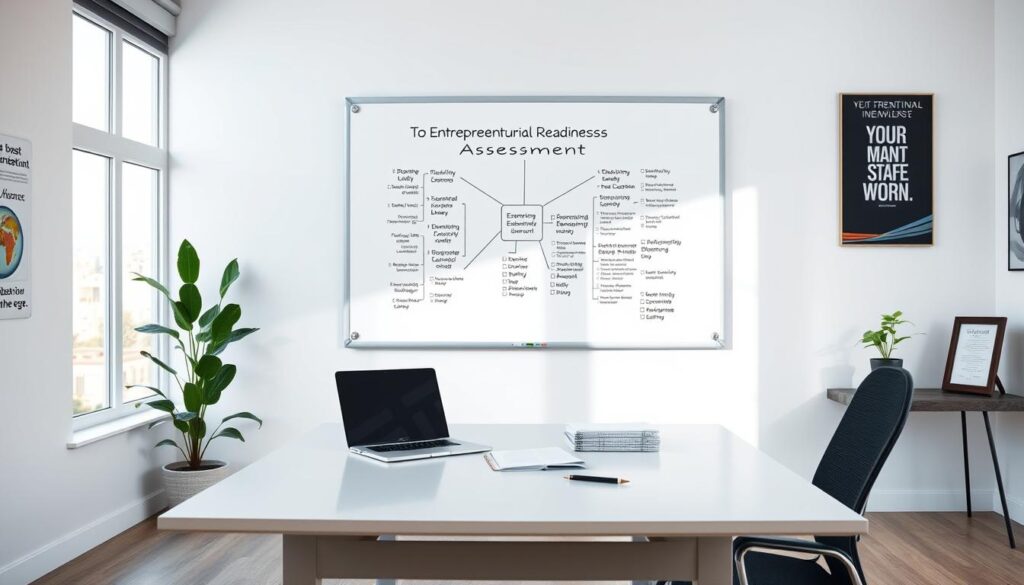Physical Address
304 North Cardinal St.
Dorchester Center, MA 02124
Physical Address
304 North Cardinal St.
Dorchester Center, MA 02124

Are you tired of the corporate grind and dreaming of being your own boss? Many people feel trapped in their 9-to-5 jobs, yearning for the freedom and fulfillment that comes with being self-employed.
Transitioning from an employee to an entrepreneur requires a significant mindset shift, but it can be a life-changing decision. Our guide is based on the experiences of successful entrepreneurs who have made this transition, offering valuable insights and practical advice.
By adopting an entrepreneurial mindset, you can break free from the limitations of a traditional job and unlock your full potential. This guide will walk you through the process, providing you with the tools and confidence to succeed.
The shift from being an employee to becoming an entrepreneur is fraught with challenges, yet it’s a journey that offers unparalleled rewards. Many individuals make this transition seeking a more fulfilling career and a better work-life balance.
There are several reasons why people choose to leave their traditional employment to start their own businesses. Two primary factors are frustrations with corporate life and the appeal of entrepreneurial freedom.
Frustrations with corporate life include limited creativity, lack of autonomy, and the often unfulfilling nature of corporate roles. Many feel constrained by the hierarchical structures and bureaucratic processes.
Entrepreneurial freedom allows individuals to pursue their passions, make their own decisions, and potentially reap the financial rewards of their hard work. This freedom is a significant draw for those looking to escape the limitations of corporate life.
The journey to becoming a successful entrepreneur is not straightforward. It involves an emotional rollercoaster and often, a different timeline than expected.
Entrepreneurs face a myriad of emotions, from excitement and euphoria to fear and disappointment. Managing these emotions is crucial for maintaining the resilience needed to navigate the challenges of entrepreneurship.
Many entrepreneurs underestimate the time it takes to build a successful business. The reality is that achieving significant milestones often takes longer than anticipated, requiring patience and perseverance.

Before diving into entrepreneurship, it’s crucial to assess your readiness for this significant career shift. Becoming an entrepreneur from an employee requires a thorough evaluation of your financial situation, skills, and support system.
To help you prepare, consider the following key areas:
Conducting a skills inventory is vital to understanding your strengths and weaknesses as a potential entrepreneur. Consider your:
Having a strong support system is critical for your success as an entrepreneur. Evaluate the support you have from:
By carefully assessing these areas, you can better understand your readiness to become an entrepreneur and make a successful transition from employee to business owner.

The journey to becoming a successful entrepreneur starts with developing the right mindset. This involves a significant shift from the traditional employee mindset to one that is more adaptable, resilient, and open to risk.
Entrepreneurship is inherently risky. To succeed, one must be willing to embrace uncertainty and view failures as learning opportunities. This doesn’t mean being reckless; it means being calculated in your risks and prepared for various outcomes.
Resilience is key to navigating the challenges of entrepreneurship. It involves being able to bounce back from setbacks and adapt to changing circumstances. Cultivating this involves developing a growth mindset and being open to continuous learning and improvement.
One of the most significant mindset shifts for new entrepreneurs is moving from an employee mentality to that of a business owner. This means thinking about long-term sustainability rather than just short-term gains, and being willing to make decisions that benefit the business as a whole.
By focusing on these areas, aspiring entrepreneurs can develop the mindset necessary to succeed in their ventures.
Finding the right business idea is a pivotal step in your entrepreneur journey, enabling you to leverage your professional expertise effectively. As you transition from being an employee to becoming an entrepreneur, it’s essential to identify a business idea that not only aligns with your skills but also meets market needs.
Your professional experience is a valuable resource for generating business ideas. Consider the skills you’ve developed, the challenges you’ve faced, and the areas where you’ve excelled. By leveraging your expertise, you can create a business that offers unique solutions or services that are in demand. For instance, if you have a background in marketing, you could start a consultancy or create digital products that help businesses improve their online presence.
Understanding market gaps and opportunities is crucial for developing a successful business idea. This involves researching your target market, analyzing consumer needs, and identifying areas where current solutions are lacking. You can use various tools and techniques, such as market surveys, competitor analysis, and social media listening, to gather insights. By doing so, you can uncover niches that are ripe for innovation and create a business that addresses these needs.
Once you have a business idea, it’s vital to validate it to ensure there’s a viable market. Validation involves testing your idea with potential customers to gauge interest and gather feedback. This can be done through various methods:
By validating your business concept, you can reduce the risk of launching a product or service that may not resonate with your target market.
Transitioning from a 9-to-5 job to self-employment requires a well-planned exit strategy. This involves deciding between a side hustle and a clean break approach, building a financial safety net, and setting a realistic timeline for your transition.
When planning your exit, you must choose between starting your business as a side hustle or making a clean break from your current employment. Both approaches have their advantages and disadvantages.
Starting as a side hustle allows you to test your business idea while still having the security of a regular income. This approach enables you to:
Deciding when to transition to full-time entrepreneurship depends on several factors, including your financial readiness and the viability of your business. It’s essential to have a clear plan and a financial safety net before making the leap.
A crucial aspect of your exit strategy is building a financial safety net. This involves:
Having a robust financial safety net will give you the confidence to pursue your entrepreneurial dreams without undue stress.
Setting a realistic timeline for your transition is vital. This includes:
A well-planned timeline will help you stay focused and motivated throughout your journey.
Embracing the entrepreneurial mindset is the first step in transitioning from an employee to a business owner. This mindset shift involves being open to new challenges and opportunities and being willing to take calculated risks.
Establishing a strong business identity is crucial for differentiating yourself in the market. This involves several key considerations.
Choosing a business name that reflects your brand values and is memorable for your target audience is essential. It’s also important to develop a brand identity that resonates with your customers.
In today’s digital age, having a professional online presence is vital. This includes creating a website and engaging on relevant social media platforms to connect with your audience.
Creating an efficient workspace is critical for productivity. This could mean setting up a home office or renting a commercial space, depending on your business needs. Consider factors such as noise levels, accessibility, and available amenities.
As an entrepreneur, managing your time effectively is crucial. Establishing routines such as regular working hours, breaks, and exercise can help maintain a healthy work-life balance. For more insights on managing the transition, you can read about the experiences of others who have made the journey from employee to business owner.
By following these practical steps, you can smoothly transition from being an employee to becoming a successful entrepreneur, embracing the challenges and opportunities that come with the transition from employee to entrepreneur.
The journey to self-employment is not just about leaving your 9-to-5 job, but also about navigating the complex legal and financial landscape of running a business. As you transition to becoming a business owner, it’s essential to understand the legal and financial implications of your new venture.
One of the critical decisions you’ll make is choosing the right business structure. This decision affects your taxes, liability, and the overall success of your business. The most common structures include sole proprietorship, partnership, limited liability company (LLC), and corporation. Each has its advantages and disadvantages, and the right choice depends on your business needs, financial situation, and long-term goals.
When deciding on a business structure, consider factors such as liability protection, tax implications, and the complexity of setup and maintenance. For instance, a sole proprietorship is simple to establish but offers no liability protection, whereas an LLC provides personal liability protection and flexibility in taxation.
As a self-employed individual, you’ll need to understand your tax obligations, including self-employment tax and income tax. You’ll report your business income and expenses on your tax return and may need to make estimated tax payments throughout the year. It’s also crucial to take advantage of deductions and credits available to businesses to minimize your tax liability.
Protecting your business and personal assets is vital. Consider obtaining liability insurance to cover potential risks and lawsuits. Additionally, other types of insurance, such as business interruption insurance and health insurance, can provide further protection and peace of mind.
In conclusion, navigating the legal and financial aspects of becoming an entrepreneur requires careful consideration and planning. By choosing the right business structure, understanding your tax obligations, and securing appropriate insurance coverage, you can set your business up for success and mitigate potential risks.
As you start your new venture, developing a comprehensive marketing plan is essential for attracting customers. Effective marketing strategies will help you establish a strong presence in the market and differentiate your business from competitors.
Creating a strong brand identity is crucial for your business’s success. This involves developing a unique value proposition, designing a compelling logo, and establishing a consistent visual brand language. Your brand identity should resonate with your target audience and reflect your business’s values and mission.
Key elements of brand identity include a memorable logo, a consistent color scheme, and a clear brand message. By investing time in building a robust brand identity, you’ll be able to create a lasting impression on your customers.
In today’s digital age, having a solid online presence is vital. Digital marketing essentials include creating a user-friendly website, leveraging social media platforms, and implementing search engine optimization (SEO) techniques. These strategies will help you reach a wider audience and drive traffic to your website.
Utilizing email marketing campaigns and content marketing can also help you engage with your audience and build brand awareness. By focusing on these digital marketing essentials, you’ll be well on your way to establishing a strong online presence.
Networking is a critical component of marketing your new business. Building relationships with other entrepreneurs, potential customers, and industry experts can lead to valuable partnerships and opportunities. Effective networking involves identifying the right events and platforms to connect with your target audience.
Utilizing online networking platforms such as LinkedIn can help you expand your professional network. Participating in online communities related to your industry can also provide valuable insights and connections.
Attending in-person networking events, conferences, and trade shows can help you establish meaningful connections with potential customers and partners. These events provide opportunities to showcase your products or services and build brand awareness.
By combining online and in-person networking strategies, you’ll be able to build a robust network that supports your business’s growth.
The path to entrepreneurial success is rarely smooth, but understanding the common pitfalls can help you navigate your journey more effectively. As you transition from employee to entrepreneur, you’ll encounter various obstacles that can test your resolve and business acumen.
One of the most significant challenges entrepreneurs face is managing irregular income. To mitigate this, it’s essential to create a budget that accounts for variable earnings and to build an emergency fund to cover at least 3-6 months of living expenses. Diversifying your income streams can also help stabilize your financial situation.
As your own boss, it’s easy to fall into the trap of working excessively long hours. To maintain a healthy work-life balance, establish a routine that includes dedicated work hours and time for rest and relaxation. Prioritizing tasks and delegating when possible can also help manage your workload effectively.
Not every business decision will be successful, and facing rejection or failure is an inevitable part of the entrepreneurial mindset. Developing resilience involves learning from mistakes, staying adaptable, and maintaining a positive outlook. Surrounding yourself with a supportive network can also provide the encouragement needed to persevere.
By understanding these common challenges and implementing strategies to overcome them, you can better navigate the complexities of starting a business from employee and build a successful entrepreneurial venture.
As you transition from being an employee to becoming an entrepreneur, embracing your new identity as a business owner is crucial. This journey requires confidence, resilience, and a willingness to learn and adapt. Becoming an entrepreneur from an employee involves a significant mindset shift, but with the right approach, you can thrive in your new role.
The path to self-employment is not without its challenges, but by understanding the realities of the employee to business owner transition, you can better prepare yourself for the journey ahead. By leveraging your skills, expertise, and support system, you can successfully navigate the transition to self-employment and build a thriving business.
As you move forward, remember that your success as a business owner depends on your ability to adapt, innovate, and persevere. With persistence and dedication, you can overcome common challenges and achieve your goals. Embracing your new identity as a business owner is the first step towards a fulfilling and successful entrepreneurial journey.